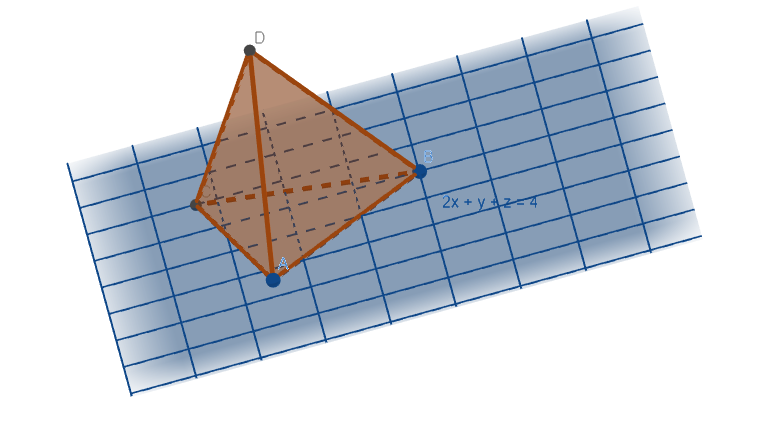Answer
385.8k+ views
Hint: We use the visual process to find the rhomboid pyramid which gives us the value of the intersecting points. We use the height to find the volume of the rhomboid pyramid. The tetrahedron will be $\dfrac{1}{4}$ volume of the pyramid. We find the volume of the tetrahedron.
Complete step by step answer:
We are going to apply the visualisation process to get the tetrahedron.
There are 4 planes involved. Three planes of the coordinates and the fourth one being $2x+y+z=4$.
The coordinate planes are $x-y,y-z,x-z$ planes. The plane $2x+y+z=4$ intersects these coordinate planes. It becomes a rhombic pyramid.
We first find the intersections.
We put the points on $2x+y+z=4$.

The intersection on the X-axis will be when $y=z=0$ and value of $x=2$.
The intersection on the Y-axis will be when $x=z=0$ and value of $y=2$.
The intersection on the Z-axis will be when $y=x=0$ and value of $z=2$.
The diagonal distance of those points will be equal to the value of the coordinates.
The points are $\left( 2,0,0 \right),\left( 0,4,0 \right),\left( 0,0,4 \right)$ and distances are $2,4,4$ units from $\left( 0,0,0 \right)$.
From the z intersection, we get the height of the hypothetical rhomboid pyramid.
From the x and y intersections, we get half of each diagonal distance across the hypothetical base.
Therefore, the height is 4 units. The area A of base will be $4\left( \dfrac{1}{2}xy \right)=2\times 2\times 4=16$.
Volume of the pyramid will be $\left( \dfrac{1}{3}Ah \right)=\dfrac{16\times 4}{3}$.
The tetrahedron will be $\dfrac{1}{4}$ volume of the pyramid. This gives $\dfrac{16\times 4}{3\times 4}=\dfrac{16}{3}$.
The volume of the tetrahedron is $\dfrac{16}{3}$.
Note:
We can also apply the calculus triple integral process to find the volume for the tetrahedron. We integrate along the three axes to find the volume.
Complete step by step answer:
We are going to apply the visualisation process to get the tetrahedron.
There are 4 planes involved. Three planes of the coordinates and the fourth one being $2x+y+z=4$.
The coordinate planes are $x-y,y-z,x-z$ planes. The plane $2x+y+z=4$ intersects these coordinate planes. It becomes a rhombic pyramid.
We first find the intersections.
We put the points on $2x+y+z=4$.

The intersection on the X-axis will be when $y=z=0$ and value of $x=2$.
The intersection on the Y-axis will be when $x=z=0$ and value of $y=2$.
The intersection on the Z-axis will be when $y=x=0$ and value of $z=2$.
The diagonal distance of those points will be equal to the value of the coordinates.
The points are $\left( 2,0,0 \right),\left( 0,4,0 \right),\left( 0,0,4 \right)$ and distances are $2,4,4$ units from $\left( 0,0,0 \right)$.
From the z intersection, we get the height of the hypothetical rhomboid pyramid.
From the x and y intersections, we get half of each diagonal distance across the hypothetical base.
Therefore, the height is 4 units. The area A of base will be $4\left( \dfrac{1}{2}xy \right)=2\times 2\times 4=16$.
Volume of the pyramid will be $\left( \dfrac{1}{3}Ah \right)=\dfrac{16\times 4}{3}$.
The tetrahedron will be $\dfrac{1}{4}$ volume of the pyramid. This gives $\dfrac{16\times 4}{3\times 4}=\dfrac{16}{3}$.
The volume of the tetrahedron is $\dfrac{16}{3}$.
Note:
We can also apply the calculus triple integral process to find the volume for the tetrahedron. We integrate along the three axes to find the volume.
Recently Updated Pages
How many sigma and pi bonds are present in HCequiv class 11 chemistry CBSE

Why Are Noble Gases NonReactive class 11 chemistry CBSE

Let X and Y be the sets of all positive divisors of class 11 maths CBSE

Let x and y be 2 real numbers which satisfy the equations class 11 maths CBSE

Let x 4log 2sqrt 9k 1 + 7 and y dfrac132log 2sqrt5 class 11 maths CBSE

Let x22ax+b20 and x22bx+a20 be two equations Then the class 11 maths CBSE

Trending doubts
Fill the blanks with the suitable prepositions 1 The class 9 english CBSE

At which age domestication of animals started A Neolithic class 11 social science CBSE

Which are the Top 10 Largest Countries of the World?

Give 10 examples for herbs , shrubs , climbers , creepers

Difference between Prokaryotic cell and Eukaryotic class 11 biology CBSE

Difference Between Plant Cell and Animal Cell

Write a letter to the principal requesting him to grant class 10 english CBSE

Change the following sentences into negative and interrogative class 10 english CBSE

Fill in the blanks A 1 lakh ten thousand B 1 million class 9 maths CBSE



